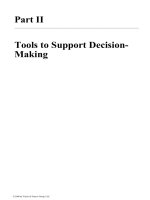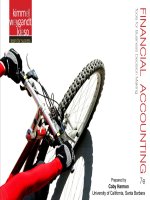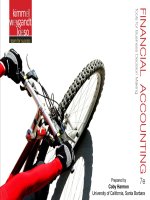Financial accounting 8e tool for busniess decision making chapter 01
Bạn đang xem bản rút gọn của tài liệu. Xem và tải ngay bản đầy đủ của tài liệu tại đây (2.47 MB, 52 trang )
1-1
1
Introduction to Financial
Statements
Kimmel ● Weygandt ● Kieso
Financial Accounting, Eighth Edition
1-2
CHAPTER OUTLINE
LEARNING OBJECTIVES
1-3
1
Identify the forms of business organization and
the uses of accounting information.
2
Explain the three principal types of business
activity.
3
Describe the four financial statements and how
they are prepared.
LEARNING
OBJECTIVE
1
Identify the forms of business organization
and the uses of accounting information.
FORMS OF BUSINESS ORGANIZATION
1-4
LO 1
USERS AND USES OF FINANCIAL
INFORMATION
Internal
Users
Illustration 1-1
Questions that
internal users ask
1-5
LO 1
ACCOUNTING ACROSS THE ORGANIZATION
Owning a Piece of the Bar
The original Clif Bar® energy bar was created in 1990 after six
months of experimentation by Gary Erickson and his mother in her
kitchen. Today, the company has almost 300 employees and is
considered one of the leading Landor’s Breakaway Brands®. One of
Clif Bar & Company’s proudest moments was the creation of an
employee stock ownership plan (ESOP) in 2010. This plan gives its
employees 20% ownership of the company. The ESOP also resulted
in Clif Bar enacting an open-book management program, including
the commitment to educate all employee-owners about its finances.
Armed with basic accounting knowledge, employees are more aware
of the financial impact of their actions, which leads to better
decisions.
1-6
LO 1
USERS AND USES OF FINANCIAL
INFORMATION
External
Users
1-7
Illustration 1-2
Questions that external
users ask
LO 1
ACCOUNTING ACROSS THE ORGANIZATION
Spinning the Career Wheel
How will the study of accounting help you? A working knowledge of
accounting is desirable for virtually every field of business. Some
examples of how accounting is used in business careers include the
following.
General management: Managers of Ford Motors, Massachusetts
General Hospital, California State University–Fullerton, a
McDonald’s franchise, and a Trek bike shop all need to understand
accounting data in order to make wise business decisions.
Marketing: Marketing specialists at Procter & Gamble must be
sensitive to costs and benefits, which accounting helps them quantify
and understand. Making a sale is meaningless unless it is a
profitable sale.
1-8
LO 1
ACCOUNTING ACROSS THE ORGANIZATION
Spinning the Career Wheel
Finance: Do you want to be a banker for Citicorp, an investment
analyst for Goldman Sachs, or a stock broker for Merrill Lynch?
These fields rely heavily on accounting knowledge to analyze
financial statements. In fact, it is difficult to get a good job in a finance
function without two or three courses in accounting.
Real estate: Are you interested in being a real estate broker for
Prudential Real Estate? Because a third party—the bank—is almost
always involved in financing a real estate transaction, brokers must
understand the numbers involved: Can the buyer afford to make the
payments to the bank? Does the cash flow from an industrial
property justify the purchase price? What are the tax benefits of the
purchase?
1-9
LO 1
USERS AND USES OF FINANCIAL
INFORMATION
Ethics In Financial Reporting
United States regulators and lawmakers were very concerned
that the economy would suffer if investors lost confidence in
corporate accounting because of unethical financial reporting.
Recent
financial scandals include: Enron, WorldCom,
HealthSouth, AIG, and others.
Congress
passed Sarbanes-Oxley Act (SOX).
Effective
financial reporting depends on sound ethical
behavior.
1-10
LO 1
USERS AND USES OF FINANCIAL
INFORMATION
Illustration 1-3
Steps in analyzing ethics cases
1-11
LO 1
ETHICS INSIGHT
Dewey & LeBoeuf LLP
I Felt the Pressure—Would You?
“I felt the pressure.” That’s what some of the employees of the nowdefunct law firm of Dewey & LeBoeuf LLP indicated when they
helped to overstate revenue and use accounting tricks to hide losses
and cover up cash shortages. These employees worked for the
former finance director and former chief financial officer (CFO) of the
firm. Here are some of their comments:
• “I was instructed by the CFO to create invoices, knowing they would
not be sent to clients. When I created these invoices, I knew that it
was inappropriate.”
• “I intentionally gave the auditors incorrect information in the course
of the audit.”
1-12
(continued)
LO 1
ETHICS INSIGHT
Dewey & LeBoeuf LLP
I Felt the Pressure—Would You?
What happened here is that a small group of lower-level employees
over a period of years carried out the instructions of their bosses.
Their bosses, however, seemed to have no concern as evidenced by
various e-mails with one another in which they referred to their
financial manipulations as accounting tricks, cooking the books, and
fake income.
Source: Ashby Jones, “Guilty Pleas of Dewey Staff Detail the Alleged
Fraud,” Wall Street Journal (March 28, 2014).
1-13
LO 1
DO IT!
1
Business Organization Forms
In choosing the organizational form for your outdoor guide service, you
should consider the pros and cons of each. Identify each of the following
organizational characteristics with the organizational form or forms with
which it is associated.
1. Easier to raise funds.
2. Simple to establish.
3. No personal legal liability.
4. Tax advantages.
5. Easier to transfer ownership.
SOLUTION
1.Corporation.
2.Sole proprietorship and
partnership.
3.Corporation.
1-14
4. Sole proprietorship and
partnership.
5. Corporation.
LO 1
USERS AND USES OF FINANCIAL
INFORMATION
Review Question
Which of the following did not result from the SarbanesOxley Act?
a.Top management must now certify the accuracy of
financial information.
b.Penalties for fraudulent activity increased.
c.Independence of auditors increased.
d.Tax rates on corporations increased.
1-15
LO 1
LEARNING
OBJECTIVE
2
Explain the three principal types of
business activity.
All businesses are involved in three types of activity —
financing,
investing,
and
operating.
The accounting information system keeps track of
the results of each of these business activities.
1-16
LO 2
FINANCING ACTIVITIES
Two primary sources of outside funds are:
1.Borrowing money (debt)
Amounts
Party
owed are called liabilities.
to whom amounts are owed are creditors.
Notes
payable and bonds payable are different
types of liabilities.
3.Issuing (selling) shares of stock for cash (equity).
Common
stock is the term used to describe the
amount paid by stockholders for shares they
purchase.
1-17
LO 2
INVESTING ACTIVITIES
Purchase of resources a company needs to operate.
Computers,
Resources
delivery trucks, furniture, buildings.
owned by a business are called assets.
Investments
are another
example of an investing
activity.
1-18
LO 2
OPERATING ACTIVITIES
Once a business has the assets it needs, it can begin
its operations.
- Amounts earned from the sale of products and
other sources (sales revenue, service revenue, and
interest revenue).
Revenues
Inventory
- Goods available for
sale to customers.
Accounts
receivable - Right to
receive money from a customer
as the result of a sale.
1-19
LO 2
OPERATING ACTIVITIES
Once a business has the assets it needs, it can
begin its operations.
- cost of assets consumed or services used.
(cost of goods sold, selling, marketing,
administrative, interest, and income taxes
expense).
Expenses
Liabilities
arising from expenses include accounts
payable, interest payable, wages payable, sales
taxes payable, and income taxes payable.
1-20
Net
income – when revenues exceed expenses.
Net
loss – when expenses exceed revenues.
LO 2
DO IT!
2
Business Activities
Classify each item as an asset, liability, common stock, revenue, or
1-21
expense.
SOLUTION
1.Cost of renting property.
1.Expense.
2.Truck purchased.
2.Asset.
3.Notes payable.
3.Liabilities.
4.Issuance of ownership shares.
4.Common stock.
5.Amount earned from providing service.
5.Revenue.
6.Amounts owed to suppliers.
6.Liabilities.
LO 2
LEARNING
OBJECTIVE
3
Describe the four financial statements
and how they are prepared.
Companies prepare four financial statements from the
summarized accounting data:
Income
Statement
Retained
Earnings
Statement
Balance
Sheet
Statement
of Cash
Flows
INTERNATIONAL NOTE The primary types of financial statements required by
International Financial Reporting Standards (IFRS) and U.S. generally accepted
accounting principles (GAAP) are the same.
1-22
LO 3
FINANCIAL STATEMENTS
Income Statement
Reports
revenues and
expenses for a specific
period of time.
Illustration 1-4
Net
income – revenues
exceed expenses.
Net
loss – expenses
exceed revenues.
Past
net income provides
information for
predicting future net
income.
▼Helpful Hint The financial statement heading identifies the company, the type of
1-23
statement, and the time period covered. Sometimes, another line indicates the unit of
measure, e.g., “in thousands” or “in millions.”
LO 3
FINANCIAL STATEMENTS
Income Statement
Illustration 1-4
Retained Earnings
Statement
Illustration 1-5
Net income is needed to
determine the ending balance in
retained earnings.
1-24
LO 3
FINANCIAL STATEMENTS
Statement
shows amounts and
causes of changes in
retained earnings during the
period.
Retained Earnings
Statement
Illustration 1-5
Time
period is the same as that
covered by the income
statement.
Users
can evaluate dividend
payment practices.
▼Helpful Hint The heading of this
statement identifies the company, the
type of statement, and the time period
covered by the statement.
1-25
LO 3









